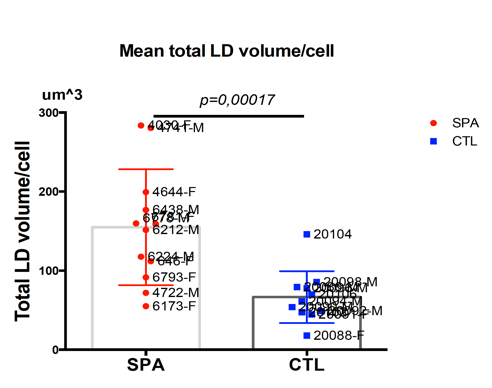Session Information
Date: Monday, November 6, 2017
Title: Spondyloarthropathies and Psoriatic Arthritis – Pathogenesis, Etiology Poster II
Session Type: ACR Poster Session B
Session Time: 9:00AM-11:00AM
Background/Purpose:
Gene expression studies are useful to investigate the pathogenesis of complex diseases. The critical role of antigen-presenting cells such as dendritic cells (DCs) being suspected in SpA, we wished to study their particular biology, starting from unbiased transcriptomic experiment.
Methods:
MDDCs were obtained from circulating CD14+ monocytes after 7 days of culture with GMCSF + IL-4. Transcriptomes were profiled using Affymetrix microarrays (HuGene 1.0 ST) and further confirmed by RNA-seq (78 million paired-end reads (2×100 nt) per sample). Differentially expressed (DE) genes between SpA (ASAS criteria) and healthy controls (HC) were listed with LIMMA. Functional annotation was performed with DAVID and InnateDB. RT-qPCR was used to test the reproducibility of the signature over time. Intra-cellular lipid dropplets (LD) volume and number were quantified by Bodipy® labeling and confocal microscopy . Cellular content of chol pathway metabolites was quantified by mass spectrometry (MS).
Results:
For transcriptomic analysis, we generated 3 lists of DE genes (nominal p < 0.01) comparing (A) HLA-B27+ SpA (n=40) to B27-neg HC (n=30), (B) B27+ HC (n=44) to B27-neg HC and (C) B27+ SpA to B27+ HC. Subtraction A–B and intersection with C yielded a robust list of 68 genes affected by SpA controlling for unrelated HLA-B27 effect. Analysis of functional pathways revealed a significant overrepresentation of genes involved in chol biosynthesis and its regulation (p < 1×10-4). Five of the 6 genes in this pathway (SQLE, MSMO1, LDLR, INSIG1, SREBF2) were downregulated in SpA. These findings were confirmed by RNA-seq on the same samples and by qPCR on a new series of samples drawn from the same group of individuals (11 SpA vs. 10 HC). Using MS, we evidenced a significant increase of chol and 27-OH-chol content in MDDC from another panel of SpA (n = 14) compared to HC (n = 8) (p < 0.05), suggesting that downregulation of cholesterol synthesis might be secondary to chol overload. Consistently, there was a highly significant increase in the size (p = 5×10-4) and overall volume (p < 2×10-4) of LD in SpA (n=12) compared to HC (n=11) MDDCs (Figure). Importantly, there was no difference of total nor fractionated chol plasma levels between SpA and controls.
Conclusion:
Our study identified a downregulation of the chol synthesis pathway in MDDCs from SpA patients that seems to be secondary to lipid overload in those cells. Our findings are consistent with a state of pre-activation of those cells that could lead to a strong inflammatory response to endogenous or environmental stimuli.
Figure:
To cite this abstract in AMA style:
Breban M, Desjardin C, Chaplais E, Talpin A, Costantino F, Hue C, Jobart-Malfait A, Maury B, Grassin-Delyle S, Bonilla N, Leboime A, Said Nahal R, Letourneur F, Jacques S, Boland A, Deleuze JF, Chiocchia G, Garchon HJ. Monocyte-Derived Dendritic Cells (MDDCs) from Spondyloarthritis (SpA) Patients Exhbit a Coordinated Downregulation of the Cholesterol (chol) Biosynthesis Pathway That Relates to Lipid Overload [abstract]. Arthritis Rheumatol. 2017; 69 (suppl 10). https://acrabstracts.org/abstract/monocyte-derived-dendritic-cells-mddcs-from-spondyloarthritis-spa-patients-exhbit-a-coordinated-downregulation-of-the-cholesterol-chol-biosynthesis-pathway-that-relates-to-lipid-overload/. Accessed .« Back to 2017 ACR/ARHP Annual Meeting
ACR Meeting Abstracts - https://acrabstracts.org/abstract/monocyte-derived-dendritic-cells-mddcs-from-spondyloarthritis-spa-patients-exhbit-a-coordinated-downregulation-of-the-cholesterol-chol-biosynthesis-pathway-that-relates-to-lipid-overload/

